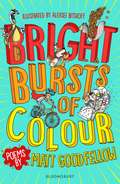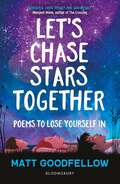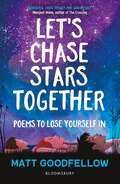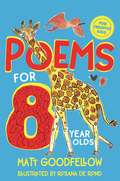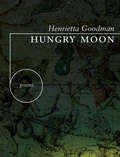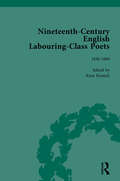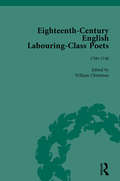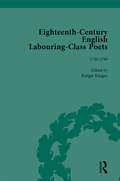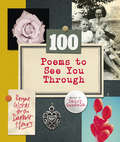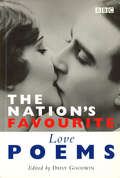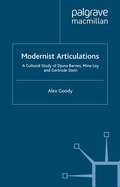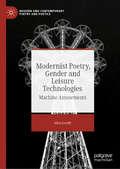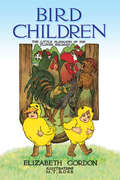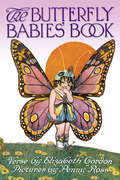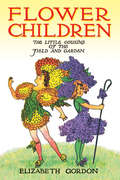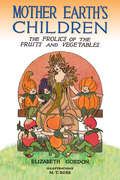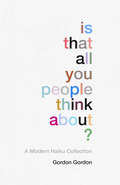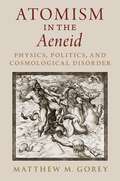- Table View
- List View
The Poetry of Dylan Thomas: Under the Spelling Wall (Liverpool English Texts and Studies #60)
by John GoodbyPublished in anticipation of the centenary of the poet’s birth, The Poetry of Dylan Thomas is the first study of the poet to show how his work may be read in terms of contemporary critical concerns, using theories of modernism, the body, gender, the carnivalesque, language, hybridity and the pastoral in order to view it in an original light. Moreover, in presenting a Dylan Thomas who has real significance for twenty-first century readers, it shows that such a reappraisal also requires us to re-think some of the ways in which all post-Waste Land British poetry has been read in the last few decades.
Bright Bursts of Colour
by Matt Goodfellow'Matt Goodfellow is a fresh voice on the children's poetry scene.' (Pie Corbett)What if cats had flavoured fur or if you swallowed the sun? What if you were a special kind of badger or if you found a map to the stars? And what if your home was split during the week: one half at Mum's, the other half at Dad's?Packed with brilliant poems that explore a whole range of themes from the downright silly to the sensitive, this collection will delight, enthuse and resonate with children and adults alike!
Bright Bursts of Colour
by Matt Goodfellow'Matt Goodfellow is a fresh voice on the children's poetry scene.' (Pie Corbett)What if cats had flavoured fur or if you swallowed the sun? What if you were a special kind of badger or if you found a map to the stars? And what if your home was split during the week: one half at Mum's, the other half at Dad's?Packed with brilliant poems that explore a whole range of themes from the downright silly to the sensitive, this collection will delight, enthuse and resonate with children and adults alike!
Let's Chase Stars Together: Poems to lose yourself in, perfect for 10+
by Matt GoodfellowA standout new collection of contemporary poems from prize-winning poet Matt Goodfellow, author of Bright Bursts of Colour.Perfectly reflecting the thoughts, feelings and imaginings of young people, these beautifully crafted poems are poignant, playful, heartfelt and hopeful.From friendship, family and separation to school experiences and fitting in, this moving collection touches on the relatable aspects of growing up. It delicately balances emotion with light relief and humour, and is sure to captivate any young person aged 10 and above.'Goodfellow has the knack for choosing all the right words.' The Guardian'Matt Goodfellow is a poet whose works are ideal for children.' Express
Let's Chase Stars Together: Poems to lose yourself in, perfect for 10+
by Matt GoodfellowA standout new collection of contemporary poems from prize-winning poet Matt Goodfellow, author of Bright Bursts of Colour.Perfectly reflecting the thoughts, feelings and imaginings of young people, these beautifully crafted poems are poignant, playful, heartfelt and hopeful.From friendship, family and separation to school experiences and fitting in, this moving collection touches on the relatable aspects of growing up. It delicately balances emotion with light relief and humour, and is sure to captivate any young person aged 10 and above.'Goodfellow has the knack for choosing all the right words.' The Guardian'Matt Goodfellow is a poet whose works are ideal for children.' Express
Poems for 8 Year Olds
by Matt GoodfellowA brilliant collection of poems for 8 year olds packed with poems about friends, space, pets, nature, magic, family, school, adventure, compiled by Matt Goodfellow.Includes classic and contemporary poems by , A.F. Harrold, Matt Goodfellow, Charles Causley, Laura Mucha, Jan Dean, Kate Wakeling, James Carter, Roger Stevens, Brian Moses and many more.
Hungry Moon (Mountain West Poetry Series)
by Henrietta GoodmanWith intimacy and depth of insight, Henrietta Goodman’s Hungry Moon suggests paradox as the most basic mode of knowing ourselves and the world. We need hunger, the poems argue, but also satisfaction. We need pain to know joy, joy to know pain. We need to protect ourselves, but also to take risks. Though the poems are drawn from personal experience, Goodman shares the conviction of such poets as Anne Sexton and Louise Glück that when the poet writes of the self, the self cannot be exempt from culpability. Goodman’s speaker ranges through time and locale—from exploring the experience of flying in a small plane with her lover/pilot over the landscape of the American West to addressing the grief and retrospective self-scrutiny that arise from a friend’s death. Like the work of Mark Doty and Tony Hoagland, Goodman’s poems embrace concrete particularity, entangled as it is with imperfection and loss: “the Quik Stop’s fridge full of sandwiches and small bottles of livestock vaccines,” “the black, hammer-struck moon of your thumb,” “the empty water tower, one rusted panel kicked in like a door.”
Nineteenth-Century English Labouring-Class Poets Vol 2
by John GoodridgeOver 100 poets of labouring class origin were published in Britain in the 18th and 19th centuries. Some were hugely popular and important in their day but few are available today. This is a collection of some of those poems from the 19th century.
Nineteenth-Century English Labouring-Class Poets Vol 2
by John GoodridgeOver 100 poets of labouring class origin were published in Britain in the 18th and 19th centuries. Some were hugely popular and important in their day but few are available today. This is a collection of some of those poems from the 19th century.
Eighteenth-Century English Labouring-Class Poets, vol 1
by John Goodridge Simon Kövesi David Fairer Tim Burke William ChristmasPoets of labouring class origin were published in Britain in the 18th and 19th centuries. Some were popular and important in their day but few are available today. This is a collection of some of those poems from the 18th century.
Eighteenth-Century English Labouring-Class Poets, vol 1
by John Goodridge Simon Kövesi David Fairer Tim Burke William ChristmasPoets of labouring class origin were published in Britain in the 18th and 19th centuries. Some were popular and important in their day but few are available today. This is a collection of some of those poems from the 18th century.
Eighteenth-Century English Labouring-Class Poets, vol 2
by John Goodridge Simon Kövesi David Fairer Tim Burke William ChristmasPoets of labouring class origin were published in Britain in the 18th and 19th centuries. Some were popular and important in their day but few are available today. This is a collection of some of those poems from the 18th century.
Eighteenth-Century English Labouring-Class Poets, vol 2
by John Goodridge Simon Kövesi David Fairer Tim Burke William ChristmasPoets of labouring class origin were published in Britain in the 18th and 19th centuries. Some were popular and important in their day but few are available today. This is a collection of some of those poems from the 18th century.
100 Poems To See You Through
by Daisy GoodwinWhen times are tough - whether because of illness, bereavement or receiving bad news - it can be hard to find the right words. Help comes in the form of this beautifully packaged gift book, comprising 100 life-affirming poems handpicked by an expert on poetry. Grouping the poems by theme - from 'Hearing Bad News' to 'How To Carry On' - this gem of a book features contributions from classical poets such as John Keats, Emily Brontë, W.H. Auden and Christina Rossetti alongside lines from more contemporary poets such as Philip Larkin, Elizabeth Jennings, Raymond Carver, Carol Ann Duffy and Wendy Cope. It adds up to a wonderful pick-me-up - a self-administered drug guaranteed to make a dark day brighter and act as a great lyrical crutch.
The Nation's Favourite: Love Poems
by Daisy GoodwinFrom the first flush of love, through courtship and vows of eternal fidelity, to serving the writs and drowning your sorrows, 'The Nation's Favourite Love Poems' will meet all your romantic requirements. In this selection of 100 popular poems, poets of every age consider that most universal of themes: love. As well as traditional lovers' favourites such as Elizabeth Barrett Browning's 'How do I love thee?' and Shakespeare's 'Shall I compare thee to a summer's day?' there are contemporary voices such as Adrian Mitchell, Wendy Cope and John Fuller, whose erudite yet salacious 'Valentine' would melt the most fridgid heart. There are even poems for those more melancholic moments, Hardy's haunting 'After a Journey', for example, and Larkin's poignant 'Love Songs in Age'. So, wherever you are in the tunnel of love, dip into this book of poetry and you will be reassured to discover that at one time or another a poet has been there before you.
Modernist Articulations: A Cultural Study of Djuna Barnes, Mina Loy and Gertrude Stein
by A. GoodyThis book explores the theoretical concerns of recent literary and cultural studies through a reappraisal of three innovative women writers of the modernist period: Djuna Barnes, Mina Loy and Gertrude Stein. In its provocative combination of cultural methodologies, it significantly expands on existing aesthetic cartographies of modernism.
Modernist Poetry, Gender and Leisure Technologies: Machine Amusements (Modern and Contemporary Poetry and Poetics)
by Alex GoodyModernist Poetry, Gender and Leisure Technologies: Machine Amusements explores how modernist women poets were inspired by leisure technologies to write new versions of the gendered subject. Focusing on American women writers and particularly on the city of New York, the book argues that the poetry of modernist women that engages with, examines or critiques the new leisure technologies of their era is fundamentally changed by the encounter with that technology. The chapters in the book focus on shopping, advertising, dance, film, radio and phonography, on city spaces such as Coney Island, Greenwich Village and Harlem, and on poetry that embraces the linguistic and formal innovations of modernism whilst paying close attention to the embodied politics of gender. The technologized city, and the leisure cultures and media forms emerging from it, enabled modernist women writers to re-imagine forms of lyric embodiment, inspired by the impact of technology on modern ideas of selfhood and subjectivity.
Bird Children: The Little Playmates of the Flower Children
by Elizabeth GordonSir Rooster is a noisy chap,He wakes you from your morning nap;He sleeps but little all night through,Crows at eleven, one and two.Brimming with antique charm, these fanciful verses and color illustrations from a century ago depict eighty-five varieties of birds. The winsome images portray men, women, and children as sparrows, storks, crows, penguins, and other familiar and exotic species. Each of the accompanying rhymes comments on the bird's habits and appearance.
The Butterfly Babies' Book
by Elizabeth GordonTo Mrs. Nettle, rough but kind,Red Admirals leave their babes to mind,And spend the golden summer hoursAmong the lovely garden flowers.Beautiful full-color illustrations and amusing verses recapture the magic and wonder of butterflies in this antique book from 1914. All of the baby butterfly characters are based on real species, and the text cites their common and scientific names and identifies the flowers and trees where they find food and shelter.
Flower Children: The Little Cousins of the Field and Garden
by Elizabeth GordonPansies like the shaded places; With their little friendly faces, Always seem to smile and say: "How are all the folks to-day?" Nostalgia enthusiasts of all ages will treasure this illustrated collection of eighty-four flower poems. Originally published in 1910, the colorful book features cute anthropomorphic images of blossoms, presented in the order of their bloom cycles. Catchy rhymes about an eager daffodil, pretty honeysuckle, and other blooms offer children a wonderful introduction to nature's beauty.
Mother Earth's Children: The Frolics of the Fruits and Vegetables
by Elizabeth GordonAsparagus in early spring Came up to hear the robins sing; When she peeped out her dress was white;It turned green in the sunshine bright .This 100-year-old collection of eighty-seven whimsical verses features color illustrations that will delight both the young and the young at heart. From apples to yams, the rhymes offer an alphabetical parade of kids dressed as fruits and vegetables: a blushing strawberry, a playful radish, carrot ladies with green-feathered hair, and other children of the earth.
Is That all You People Think About?: a collection of modern haikus
by Gordon Gordon'A fine, if sometimes rude, collection of haikus inspired by modern life' Daily Telegraph‘I’m in here!’ yelled Mum.Hide and seek was spoilt again.We never found Dad.The word ‘Haiku’ invokes images of misty mountains, running streams and falling leaves. But where are the haiku that reflect the modern world we live in? The real world of overflowing baths, train delays and Pierce Brosnan?In this collection, you will find a haiku for every moment of modern life, all rendered in no more or less than 17 syllables.
Atomism in the Aeneid: Physics, Politics, and Cosmological Disorder
by Matthew M. GoreyScholars have long recognized Lucretius's De Rerum Natura as an important allusive source for the Aeneid, but significant disagreement persists regarding the scope and purpose of Virgil's engagement with Epicurean philosophy. In Atomism in the Aeneid, Matthew M. Gorey investigates that engagement and argues that atomic imagery functions as a metaphor for cosmic and political disorder in Virgil's epic, associating the enemies of Aeneas and of Rome's imperial destiny with the haphazard, purposeless chaos of Epicurean atoms in the void. While nearly all of Virgil's allusions to atomism are constructed from Lucretian intertextual material, Gorey shows how the poet's negative reception of atomism draws upon a long and popular tradition of anti-atomist discourse in Greek philosophy that metaphorically likened the non-teleological cosmology of atomism to civic disorder and mob rule. By situating Virgil's atomic allusions within the tradition of philosophical opposition to Epicurean physics, Atomism in the Aeneid illustrates the deeply ideological nature of his engagement with Lucretius.
Atomism in the Aeneid: Physics, Politics, and Cosmological Disorder
by Matthew M. GoreyScholars have long recognized Lucretius's De Rerum Natura as an important allusive source for the Aeneid, but significant disagreement persists regarding the scope and purpose of Virgil's engagement with Epicurean philosophy. In Atomism in the Aeneid, Matthew M. Gorey investigates that engagement and argues that atomic imagery functions as a metaphor for cosmic and political disorder in Virgil's epic, associating the enemies of Aeneas and of Rome's imperial destiny with the haphazard, purposeless chaos of Epicurean atoms in the void. While nearly all of Virgil's allusions to atomism are constructed from Lucretian intertextual material, Gorey shows how the poet's negative reception of atomism draws upon a long and popular tradition of anti-atomist discourse in Greek philosophy that metaphorically likened the non-teleological cosmology of atomism to civic disorder and mob rule. By situating Virgil's atomic allusions within the tradition of philosophical opposition to Epicurean physics, Atomism in the Aeneid illustrates the deeply ideological nature of his engagement with Lucretius.

